When people go to georgia, they love to hike a lot. This experience is even richer if you know more about the local wildlife. Speaking of wildlife, would you have guessed that Georgia is home to a wide variety of frog species?
What? Sounds surprising? But it’s actually true. These amphibians contribute a lot to maintain a healthy environment in georgia. So the next time you visit, you should definitely look for them, but beware- they got some poisonous frogs too.
You should also know about them beforehand whether you’re interested in encountering them or keeping them as pets.
As you read on, check out the list of frogs found in Georgia. To help you recognize dangerous species and prevent injury, we will identify the big, little, invasive, and dangerous species for you.
What tree frogs live in Georgia?
Frogs may look alike on the outside, but their habitats, habits, croaks, and other physical traits allow us to tell them apart.
Some of them burrow underground and emerge in the rain, but the majority live in ponds, lakes, and streams. Even so, tree frogs prefer the trees to the water for most of their time.
In Georgia, during the warm months, large groups of males will sing nightly choruses that are distinctive to the green tree frog. They typically hang out in trees, eating insects. Occasionally, you can see them clinging to smooth surfaces like sliding glass doors and windows.
Below is a list of a few different species of tree frogs that are typically found in Georgia:
- Green Tree Frog
- Spring Peeper
- Gray Tree Frog
- Northern Cricket Frog
- Southern Cricket Frog
- Pine Woods Tree Frog
- Squirrel Tree Frog
- Barking Tree Frog
- Little Grass Frog
- Cuban Tree Frog
- Bird-voiced Tree Frog
- Southern Chorus Frog
- Brimley’s Chorus Frog
- Mountain Chorus Frog
- Upland Chorus Frog
- Ornate Chorus Frog
16 tree frogs are found in Georgia
Georgia is home to 85 different species of amphibians; North Carolina is the only other state with a higher diversity of amphibians. Numerous different species from several different families can be found in Georgia. In 2005, the green tree frog was named the official state amphibian of Georgia.
Green Tree Frog
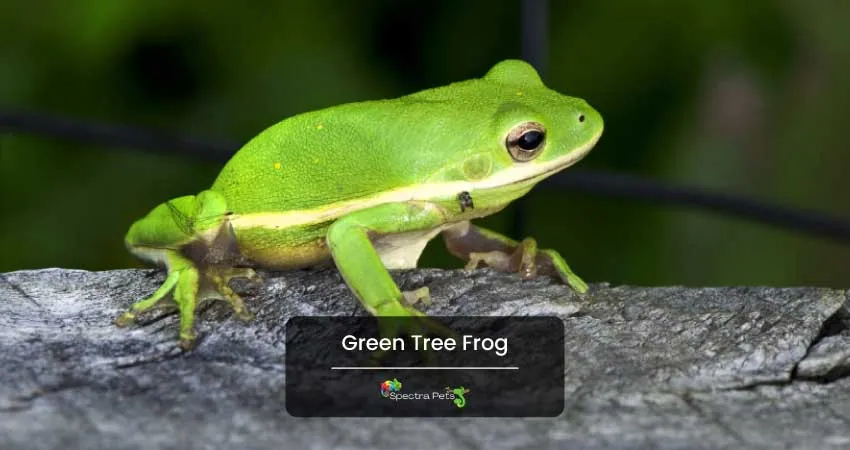
- Family : Hylidae
- Scientific name: Dryophytes cinereus
- Size : 2 to 2.5 inches
- Longevity : 2 to 6 years
Green tree frogs live in Georgia’s southern region. These tiny amphibians reside in heavily vegetated swamps, ponds, and other bodies of water.
These anurans live in good numbers in the state and spend a lot of time up in the trees. They breed from March to October, and the males can be heard calling from the water.
Green tree frogs have a medium to bright green color. Long limbs and a white stripe running down their sides distinguish them. Some of them have tiny yellow spots on their backs, and males are typically smaller than females.
Since they are nocturnal, these amphibians spend the majority of their time in dense vegetation. Because of how they blend in, they are less vulnerable to predators.
These anurans can be kept as pets, but because they are so tiny, handling them causes them harm.
Spring Peeper
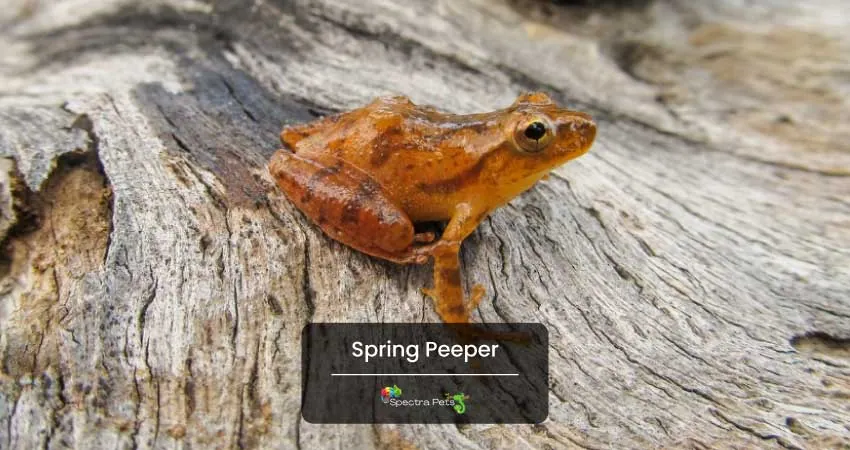
- Family: Hylidae
- Scientific name: Pseudacris crucifer
- Size : 0.75 to 1.25 inches
- Longevity: 2 to 4 years
Spring Peepers can be found all over the state of Georgia. They are a species of chorus frog and one of the first to reappear after the winter. Typically, their mating call signals the start of spring.
These anurans inhabit various types of woodlands and forests close to permanent bodies of water. They only enter the water to breed and spend the majority of their time on land.
Spring peepers can be brown, tan, or olive in hue. Sometimes these frogs can be gray. The majority of them have white bellies. They have a dark bar pattern all over their body and an X mark on their back.
Males have light skin tones and dark throats. Their chirping usually begins in the beginning of spring. The spring peeper is nocturnal and feeds exclusively on insects. Some of the foods they consume include ants, flies, and beetles.
Predators of this species include raptors, salamanders, snakes, and other birds.
Gray Tree Frog
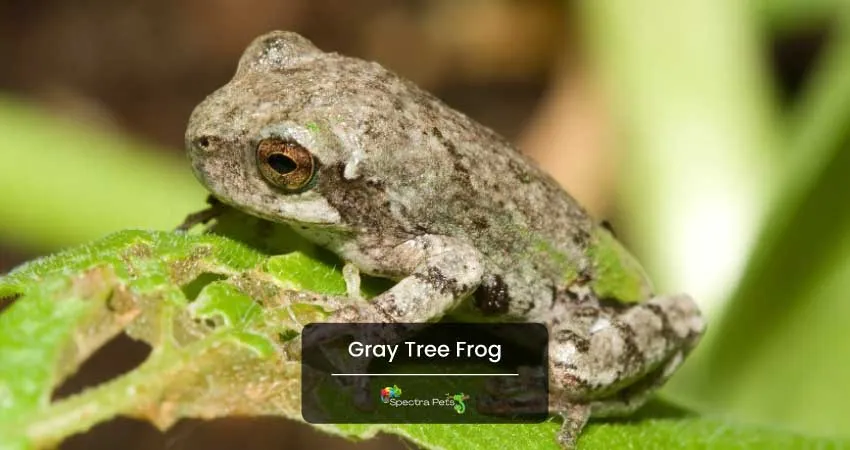
- Family: Hylidae
- Scientific name: Hyla versicolor
- Size: 1 to 1.25 inch
- Longevity: 7 to 10 years
The entire state of Georgia is home to gray tree frogs. They are the most widespread frog species found in the piedmont and mountains.
Gray tree frogs reside in woodland areas and other wet forests. These small anurans will reproduce in fishless waters and are most active in the summer.
The colors of gray tree frogs range from gray to light green, changing shades as they move. Their bodies are large and heavy. These amphibians have different shades depending on their environment. The inner thighs of these species are a vivid yellow or orange with spots.
These amphibians are nocturnal and spend the day in hiding in remote locations. They go bug hunting at night for insects and other tiny invertebrates. These nocturnal species spend most of their time high in the trees.
Northern Cricket Frog
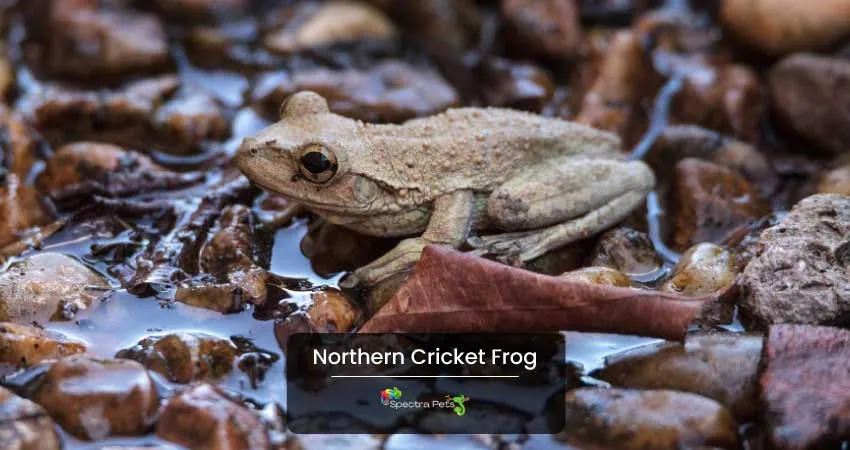
- Family: Hylidae
- Scientific name: Acris crepitans
- Size : 0.75 to 1.5 inches
- Longevity: 5 to 10 years
The majority of Georgia is home to northern cricket frogs, but the state’s southern regions are devoid of them.
They are frequently found along the edges of still lakes, ponds, and other bodies of water. Shallow waters with dense vegetation make excellent habitats for them. These anurans are not good climbers and spend the majority of their time on the ground.
Northern cricket frogs come in hues of brown, green, and olive and have a dark bar pattern on their bodies. These creatures are tiny and warty. There is a triangular mark on the top of their heads.
The daytime hours are when northern cricket frogs are most active. The diet of these amphibians consists of insects like spiders, flies, and mosquitoes.
Birds and other large frogs will often prey on this species, and they use their legs to jump and escape.
Southern Cricket Frog
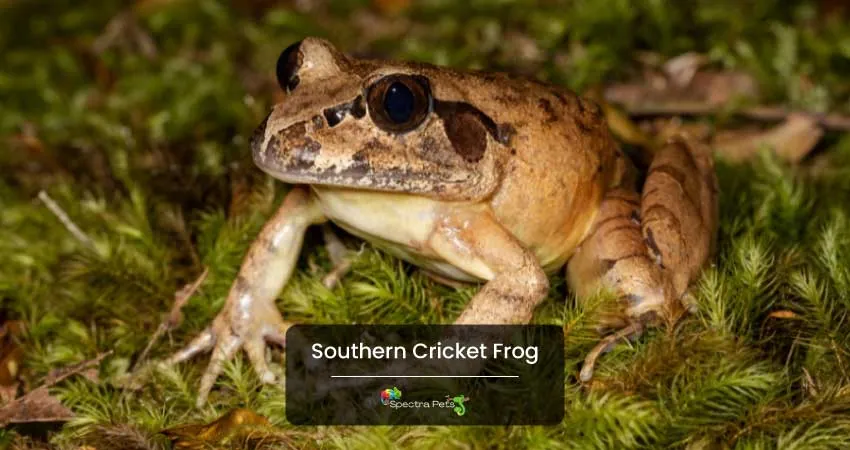
- Family: Hylidae
- Scientific name: Acris gryllus
- Size : 0.75 to 1.5 inch
- Longevity: 5 to 10 years
The southern half of Georgia is home to southern cricket frogs, which are typically found near the edges of still water sources.
The males become aggressive in their pursuit of a mate during the breeding seasons in the spring and summer. They resemble the Northern Cricket frog in appearance, but their call allows you to tell them apart. These little creatures call with a clicking noise. However, it clicks slower than their Northern counterparts .
These amphibians are gray, brown, or green in color, with a dark triangular pattern on their heads.
Insects are the main food source that they depend on to stay alive. Since they struggle with climbing, they spend the majority of their time on the ground.
Pine Woods Tree Frog
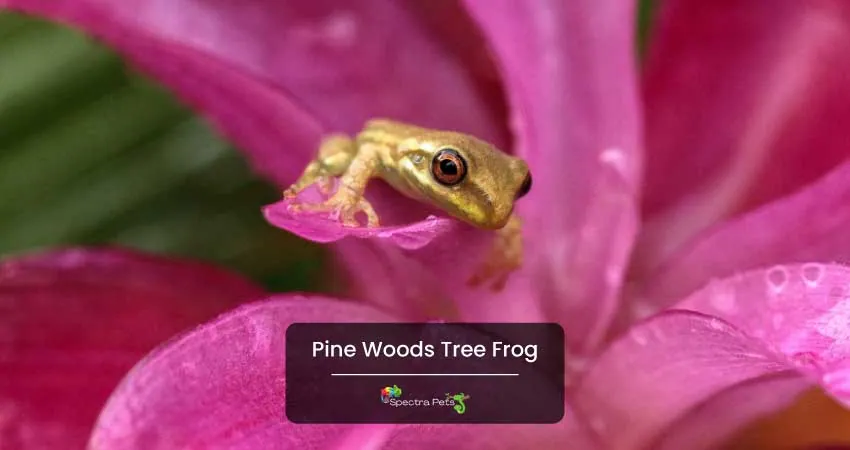
- Family : Hylidae
- Scientific name: Hyla femoralis
- Size : 1 to 1.5 inches
- Longevity : 4 to 4.5 inches
Pine Woods Tree Frogs can be found in Georgia’s southern region. They breed in temporary ponds and reside in forests. Some people refer to this species as the Morse Code Frog because of its sporadic chattering call.
The color of these tiny anurans ranges from yellow to orange to brown to reddish to tan. Their bodies are shiny, smooth, and have moist skin. There are several marks on their thighs. They have big, webbing-covered toes on their feet. This particular amphibian is fairly common in its area and feeds on insects.
From spring through fall, they are most active because of breeding. These amphibians will hide in shadowy, concealed areas during colder weather, such as under logs or decaying stumps.
Squirrel Tree Frog
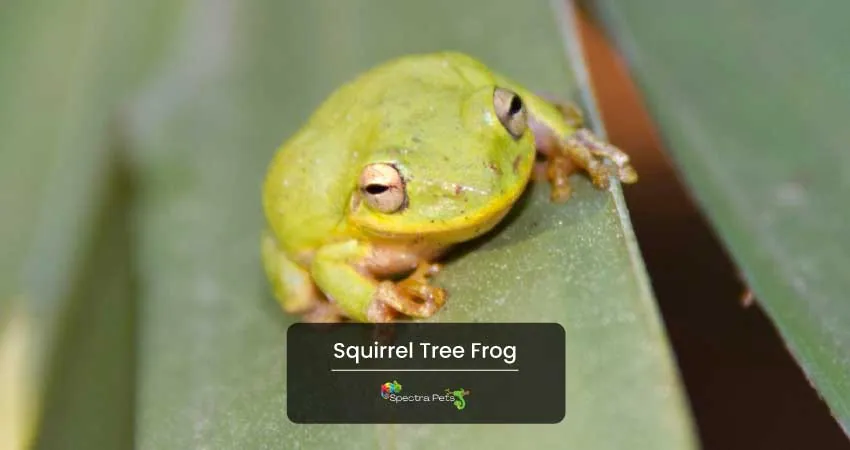
- Family : Hylidae
- Scientific name: Hyla squirella
- Size : 1 to 1.5 inches
- Longevity : 5 to 9 years
Georgia’s southern region is home to the squirrel frog.
They can be found in swamps, marshes, and other habitats that are near water. This species prefers dense vegetation for hiding and climbing.
Squirrel tree frogs can be found in a wide range of colors like green, tan, and gray. They are able to change their shade to help blend in with the environment. Some have stripes on their legs and in the area around their eyes. The skin of this species can be spotted or have no pattern. They are distinguished from other tree frogs by determining which species they are not, despite having a similar appearance.
The squirrel frog breeds during heavy rain. These tiny anurans are nocturnal but occasionally go hunting during the day if starving. These amphibians will typically be drawn to porch lights that draw insects.
Barking Tree Frog
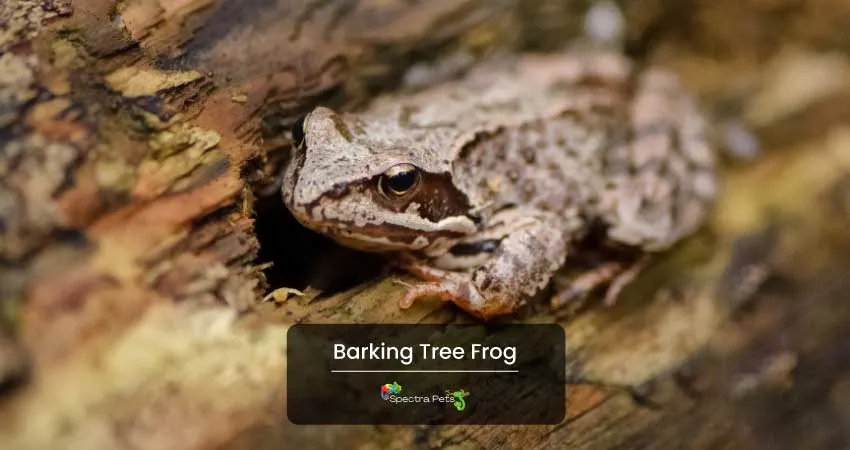
- Family : Hylidae
- Scientific name: Dryophytes gratiosus
- Size : 2 to 2.75 inches
- Longevity : 5 to 10 years
Barking tree frogs are found in Southern Georgia. For breeding, they inhabit wooded areas close to bodies of water without fish.
March through late August are their breeding months. In order to attract a mate, males will “donk” and are visible floating on the water’s surface.
The Barking Tree Frog is one of the biggest tree frog species in the state. They have a large frame and skin that is bright green. Their backs are covered in tiny light brown blotches, and their large webbed toes are also brown.
These hunting amphibians prey on insects like flies, spiders, and beetles. Like most tree frogs, this species spends most of its time in trees, which helps it avoid predators. In order to avoid predators, this species, like the majority of tree frogs, spends the majority of its time in trees.
Little Grass Frog
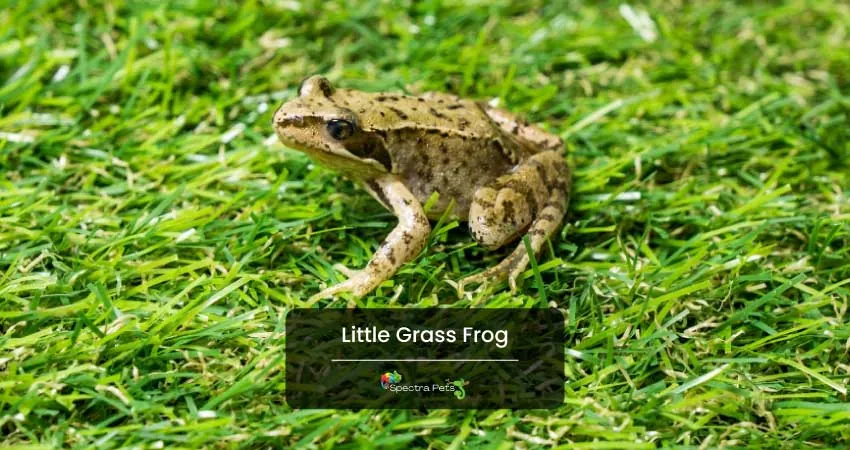
- Family : Hylidae
- Scientific name: Pseudacris ocularis
- Size : 0.75 inches
- Longevity : 5 to 10 years
The little grass frog can usually be seen on the coastal plains in wetland habitats. They call all year long and are active from late winter to September. Their primary habitats are densely forested areas. They are the tiniest species found in Georgia and North America.
This particular amphibian has pointed heads and slender bodies that can be green, brown, red, or occasionally pink. Their bodies have a series of dark stripes that are visible along with other patterns.
These frogs are small enough to comfortably fit on the tip of your finger. Because of the size, this species is easy to identify.
These tiny anurans can leap 2 feet long and avoid predators thanks to their powerful legs. The diet of these small amphibians consists of tiny insects that are found in the soil. Most big animals can eat them because they are vulnerable to them.
Cuban Tree Frog
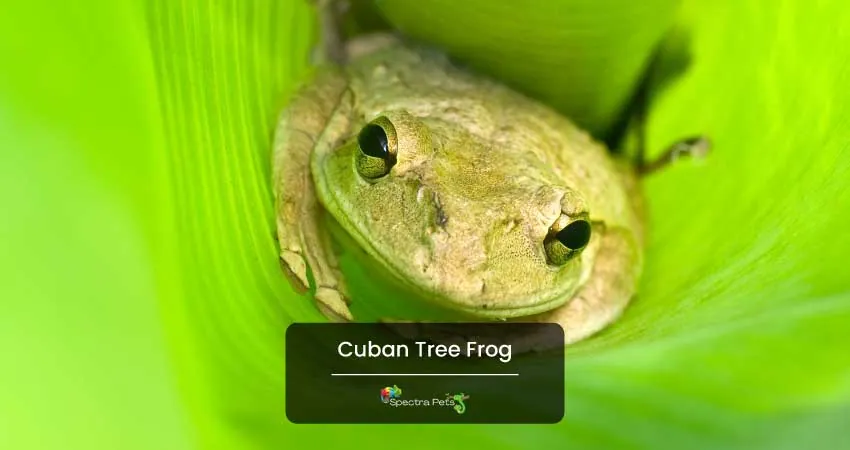
- Family : Hylidae
- Scientific name: Osteopilus septentrionalis
- Size : 2 to 6 inches
- Longevity : 5 to 10 years
The Cuban Tree Frog is an invasive species. They are scattered in small numbers throughout Georgia. It has the potential to become quite large and will consume the neighborhood tree frogs, greatly reducing their population. The Cuban tree frog, however, still makes a fantastic pet. You can typically find them in your neighborhood pet store, despite its issues.
Bird-voiced Tree Frog
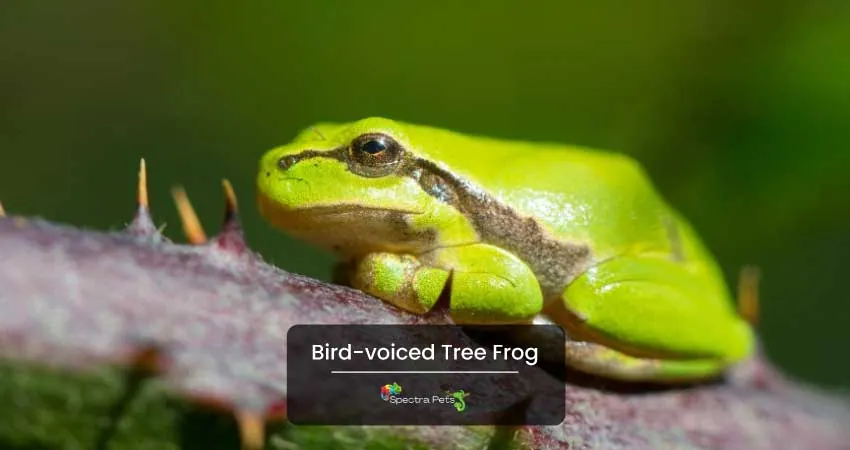
- Family : Hylidae
- Scientific name: Hyla avivoca
- Size : 2 inches
- Longevity : 2.5 to 4 years
Bird-voiced tree frogs inhabit forested areas close to rivers, swamps, and streams. This is a nocturnal species that lives among the trees and is primarily active at night.
These anurans are rarely seen on the ground except to breed in late spring or early summer. They reproduce in temporary, densely vegetated water pools.
Bird-voiced tree frogs are small in size, and their colors range from gray to brown. Activity and temperature will alter their color.
They develop dark cross patterns on their legs and back. Between their legs, these amphibians are colored yellow, and their belly is a pale gray color. This species hunts at night and feeds on insects.
You can hear them calling when they breed close to ponds and other water sources. The species gets its name from the sound of its call, which is like a bird.
Southern Chorus Frog
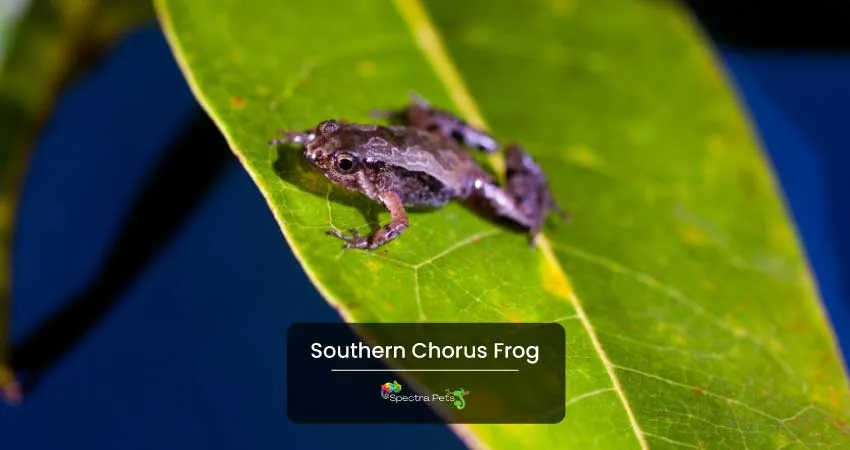
- Family : Hylidae
- Scientific name: Pseudacris nigrita
- Size : 0.75 to 1.25 inches
- Longevity : 1 to 3 years
You can find southern chorus frogs in wetlands, forests, meadows, and ditches.
They mate in the spring after laying their eggs attached to debris in the water. The majority of this species’ active hours are spent in bodies of water close to densely forested areas. They also live in sandy soil and dig tunnels beneath the ground.
The Southern Chorus Frog and the Upland Chorus Frog share a similar appearance, despite having different ranges.
These amphibians have pale bellies and are brown, gray, or green in color. They have pointed snouts and a white spot above the lip.
Southern chorus frogs feed on ants, flies, and other tiny insects. Predators include large amphibians, birds, and water snakes. This species is elusive and challenging to research.
Brimley’s Chorus Frog
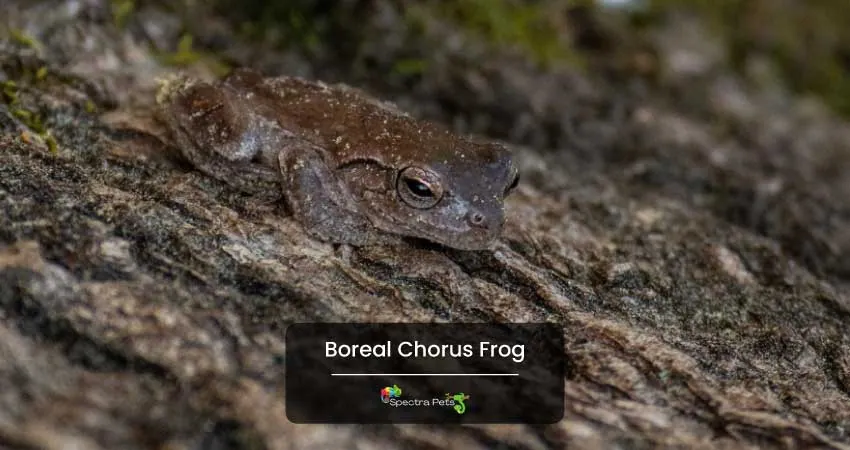
- Family : Hylidae
- Scientific name: Pseudacris brimleyi
- Size : 1 to 1.33 inches
- Longevity : 1 to 3 years
A small portion of Georgia’s coastal plains is home to Brimley’s Chorus Frogs. These anurans inhabit wetlands, scrubby areas, and forests. Springtime is this species’ breeding season. They lay their eggs in wetlands with lush vegetation.
This diminutive species of chorus frog comes in a variety of hues, from green to dark brown. The sides of their eyes have a dark stripe that extends all the way to their groin. They have brown markings on a yellow belly.
Due to their secrecy and restricted range, this species is uncommon in Georgia. They eat only tiny insects to survive. During the winter, they burrow down and go into brumation.
Mountain Chorus Frog
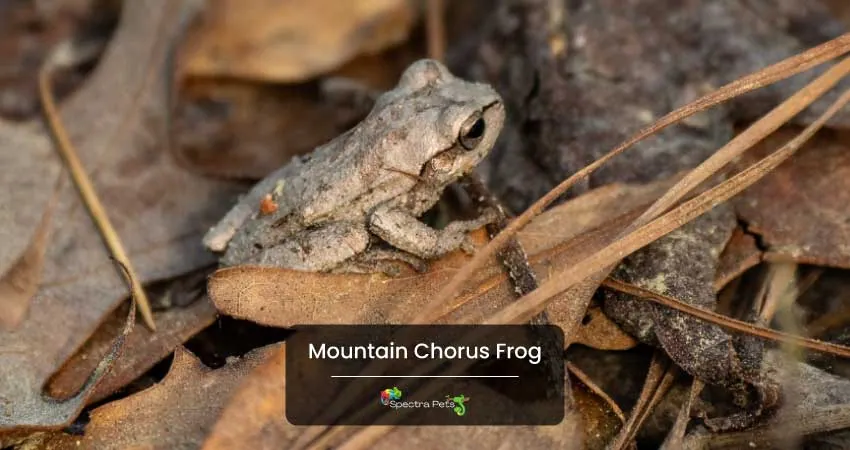
- Family : Hylidae
- Scientific name: Pseudacris brahcyphona
- Size : 1 to 1.25 inches
- Longevity : 1 to 3 years
A small area of Georgia’s northern mountainous regions is home to mountain chorus frogs. They live in habitats with lots of vegetation, including forests and woodlands. They breed in shallow bodies of water like streams, ponds, and other similar areas.
The Mountain Chorus Frogs are small and have a green to olive hue. They can be recognized by the yellow coloring between their legs. There is a reverse parenthesis-like pattern on their backs. A dark triangular pattern is present between their eyes as well.
In spring, breeding takes place. They may be difficult to locate in the summer. The sound of a finger going through a comb can be compared to a male’s mating call.
These creatures hide during the hotter season beneath leaf litter and other natural debris.
Mountain chorus frogs are insectivores and spend the majority of their time in trees. They hunt with their sticky tongues.
Upland Chorus Frog
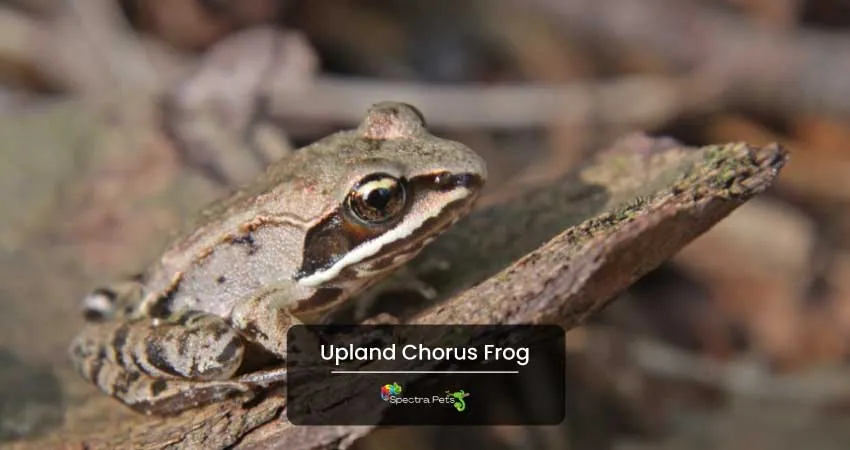
- Family : Hylidae
- Scientific name: Pseudacris feriarum
- Size : 0.75 to 1.75 inches
- Longevity : 1 to 5 years
Bogs, marshes, wetlands, and grassy areas are all good places to look for the upland chorus frog. They breed in slow-moving water sources and are active from spring to fall.
Their mating call is comparable to that of other chorus frogs but is longer and shaken-sounding.
This is a species that comes in various brown and gray tones. They have stripes down their backs and a light line across their lips.
Males have a sizable, dark-colored vocal sack.
This species primarily consumes insects. Despite being a common frog species, they are only present in the state’s northern half.
Ornate Chorus Frog
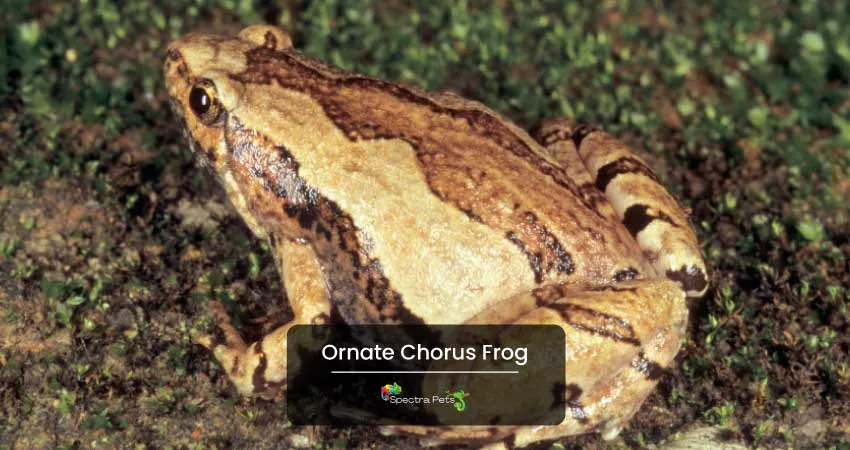
- Family : Hylidae
- Scientific name: Pseudacris ornata
- Size : 1 to 1.5 inches
- Longevity : 1 to 3 years
Ornate Chorus Frogs are seen in the southern half of Georgia, as well as the far eastern states of the U.S. woodlands, wetlands, and grassy areas in the coastal plains. Their secretive nature makes them difficult to locate outside of their breeding season. These amphibians breed in small, temporary water sources.
These amphibians are a tiny and vibrant species. They have a blotchy mask covering their eyes and can be gray, green, or reddish-brown in color. These anurans have smooth, moist skin with a few tiny yellow spots between their legs.
Despite being common, these nocturnal creatures are seldom seen. This species breeds in the wintertime during heavy rain. Due to disease, predators, and habitat loss, their population has experienced some decline.
Where do tree frogs in Georgia live?
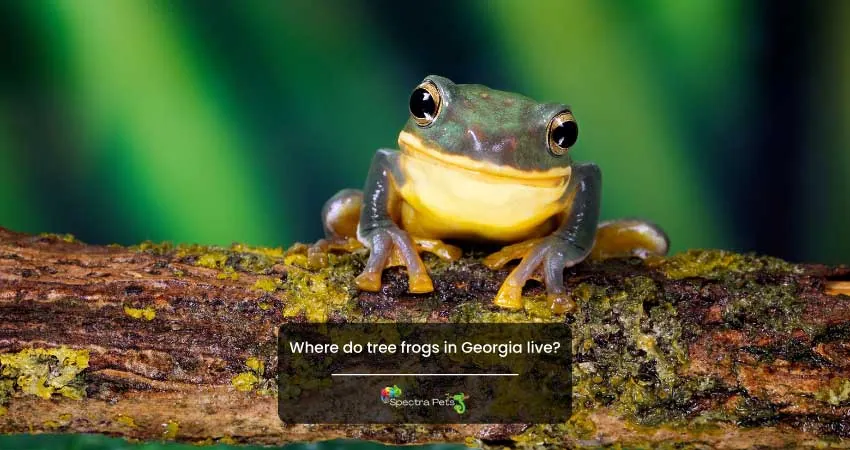
Tree frogs are arboreal, which means they typically live in trees. However, not all species of tree frogs live in trees. You can also pretty commonly find them near water bodies, especially after rainfall.
How long do Georgian Tree Frogs live?
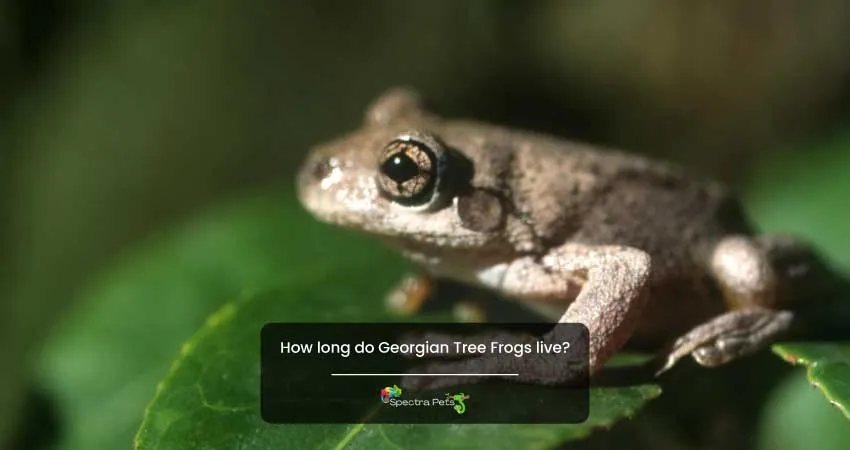
Tree frogs live between 3-6 years on average. Smaller ones usually have a lifespan as short as a few months, during which they must ensure the survival of the next generation. If nurtured properly, larger creatures can live up to 21 years.
The larger species of tree frogs have a longer lifespan. The main reason for this is that these larger amphibians can more easily regulate their body temperature. Also, they have an innate resistance to starvation and require less food.
What do Georgian tree frogs eat?
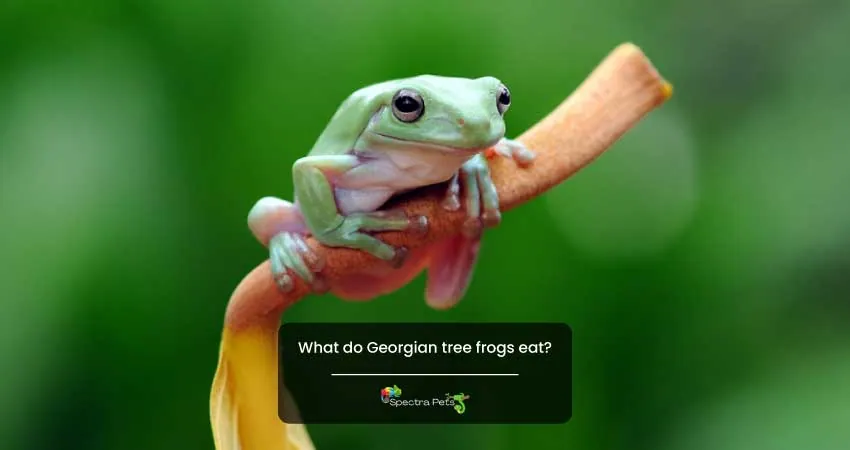
To maintain a balanced diet, tree frogs can consume a variety of insects such as worms, crickets, flies, moths, and ants. This marks them as insectivores.
The sole source of nutrition for American green tree frogs is insects. A green tree frog’s diet might consist primarily of crickets.
This family of amphibians comparatively consume more food during the summer as well as in the spring. They do not need as much food during the winter, as they go into hibernation. Smaller ones should be fed daily, whereas larger ones can be given food every other day. Each feeding should provide food for three to four insects.
Due to their opportunistic feeding habits, these amphibians can gain weight quickly. If it looks like your frog is getting overweight, cut back on the number of feedings you give him each week. More space to move around and opportunities for exercise might also be helpful if your frog seems overweight.
Are Georgian tree frogs poisonous?
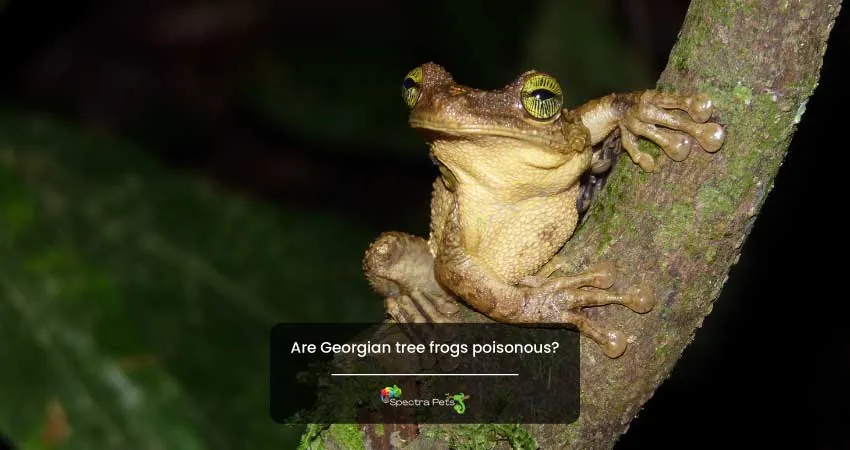
Some tree frogs have the potential to be poisonous, while others don’t. A frog’s color can be used to determine whether it’s dangerous or not. Some amphibians with striking colors are deadly to humans, such as poison dart frogs. However, tree frogs can only cause minor skin rashes, and salmonella is the absolute worst-case scenario.
Fortunately, Georgia only has one poisonous species—the pickerel frog. This amphibian’s venom helps deter snakes and other predators, but it can also cause minor skin irritation in people, especially if they handle it frequently. There is no danger from these creatures, though, as long as you don’t get toxins into your eyes or other delicate areas of your body.
Can I touch a Georgian Green Tree Frog?
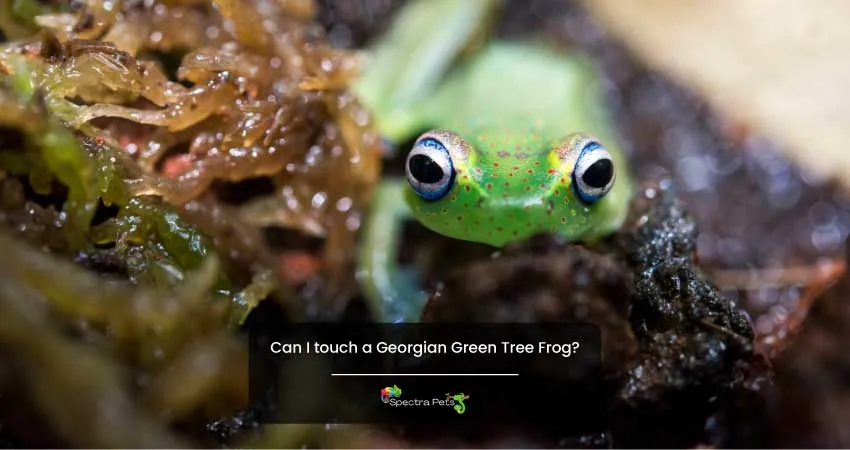
Tree frogs are not aggressive or poisonous. Refraining from touching them is recommended and most beneficial to the amphibian.
Their skin absorbs oxygen and other chemicals from the environment. So, if you hold them with dirty hands, you risk spreading those chemicals to them. Tree frogs can have their immune systems weakened by chemicals because they absorb them so quickly. Weak immune systems will let bacteria in, which will lead to illness. Skin irritations and Salmonella bacteria are the two biggest risks you run when handling them.
Are Georgian tree frogs invasive?
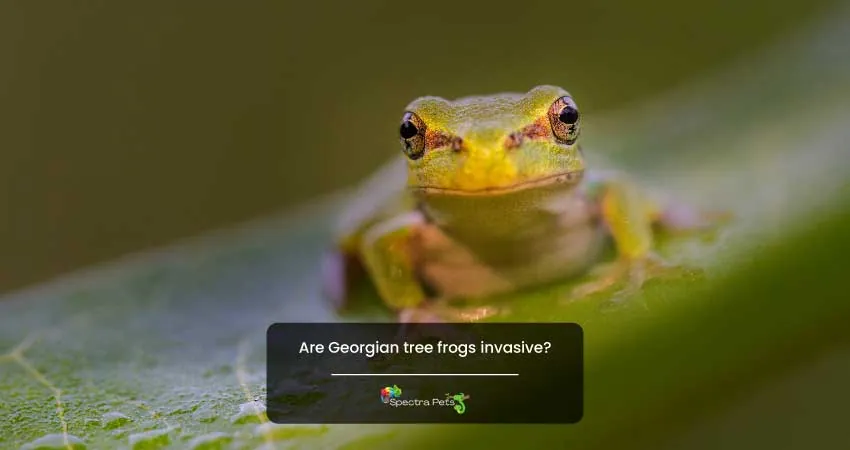
Most of the Georgian tree frogs are not invasive by nature. However, the Southern Leopard frog and the Cuban Tree frog are two species you want to be careful of if you’re worried about a frog invasion. Contact the local wildlife commission if you spot a large gathering of these creatures.
Wrapping up
Each frog has a distinct personality and set of traits. Some, like the green tree frog or leopard frog, can even be kept as pets. You should be aware of their needs and the species it belongs to before keeping it as a pet. A few of these creatures can even live up to 10 years, making them excellent companions.
So, now that you know about the various kinds of tree frogs in Georgia. Did any one of them were to your liking? Let me know in the comments section below!
Tree Frogs Found in the Nearby States of Georgia:
